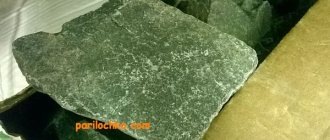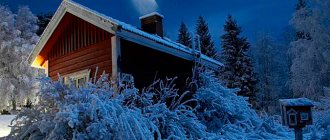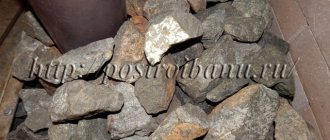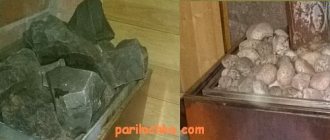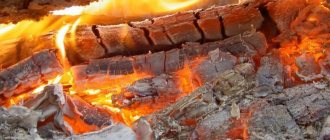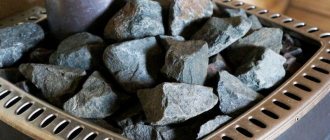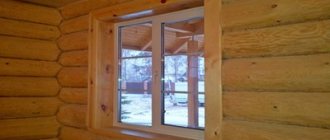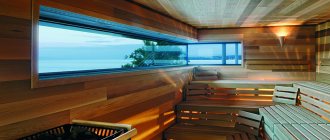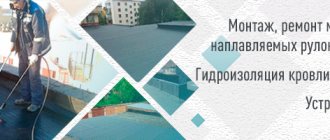Traditionally, natural stones are used in sauna stoves. They are valued for their ability to quickly accumulate heat and release it slowly. In general, minerals provide health benefits and play an essential role in the sauna atmosphere. The stones used in the steam room include sauna porphyry. It has been known to people for many centuries, since the times of Ancient Rome.
Types of stones for baths
Today there are a large number of stones that can be used for baths. The most important thing is not to get confused in such a variety and choose the appropriate option. The most affordable option is considered to be pebbles for a bath. If necessary, you can lay it yourself. To make the masonry dense, you should choose oval stones with a flattened shape. For greater efficiency, you can purchase high-quality rock and use pebbles to fill the bottom layer.
Attention! It is not recommended to use rocks with red inclusions, since the process of heating begins the process of releasing iron oxide.
Jadeite for baths
Jadeite is another representative of semi-precious minerals. Unlike jade, this type of stone is inferior in cost - it is much lower, and in terms of performance characteristics - it can last up to 5 years with constant use. Thanks to its litho-therapeutic properties, it helps stabilize blood pressure and improves the functioning of the endocrine system and circulatory system. Jadeite is considered one of the expensive options.
Jade for bath
Jade is considered a semi-precious mineral, which has ideal characteristics unlike other types of stones. Durability of use can reach 10 years. Despite this, such popularity is not due to its attractive appearance, but due to the litho-therapeutic effect of the mineral. Jade has a beneficial effect on the skin and improves metabolism. In addition, it is able to relieve a person from insomnia and perfectly relieves fatigue.
Porphyrite for a bath
When considering porphyrite, it is worth noting that this mineral is characterized by a high level of strength, excellent thermal conductivity, and has an acceptable cost. If installed correctly in a heater, the service life of the material can be 5 years or more. A steam room equipped with this stone has a beneficial effect on the respiratory system and perfectly relieves headaches, including migraines.
Rodingitis
Rodingite is a metamorphic rock that was formed as a result of the alteration of deep-seated igneous rocks under the influence of high pressure, high temperatures, carbonate solutions and hydrothermal acids. If we take into account the technical characteristics, it is worth noting the high level of strength. During operation, the stone is not subject to destruction and practically does not expand when heated, which allows you to increase the service life of the mineral.
Gabbro-diabase
Today, gabbro-diabase is the most popular stone, as it can be found almost everywhere. A distinctive feature is a high level of heat capacity, strength, and at the same time it has an acceptable cost, as a result of which everyone can afford it. Among the disadvantages, it is worth noting the unpleasant odor during the heating process and the appearance of soot when essential oils get in contact with it.
Important! No litho-therapeutic properties have been found in gabbro-diabase for baths, but it retains heat well.
Quartzite for baths
Quartzite has excellent technical characteristics, among which are a high level of heat resistance and heat capacity. For the bath, you can use both crushed and rounded quartzites, which have been processed using mechanical grinding. Small streamlined stones are great for small heaters. In addition, quartzites heat up quite quickly and retain heat for a long time.
Stone coil for bath
The coil used during bath procedures has an excellent effect on the overall health of a person. This stone is able to draw out all existing negative emotions and has a calming effect. That is why the coil is used during the treatment of physical and mental illnesses. This mineral copes well with migraines, with inflammatory processes in the digestive system, and helps the body cleanse itself of existing toxins.
Basalt for baths
Basalt is a mineral of volcanic origin, which has excellent heat capacity and high resistance to temperature changes; in addition, no cracks are observed when water enters. It is characterized by high durability and low cost. The mineral is believed to have a beneficial effect on the skin and help relieve stress.
Dunit for baths
Dunite is another mineral with high thermal conductivity and resistance to sudden temperature changes. The stone is durable; if it is placed correctly in the heater, its service life can be more than 6 years. The color can vary from olive to black. Previously, dunite was the most popular mineral. Great for helping with colds.
Chromite for baths
It would seem that chromite has an inconspicuous appearance, but is very popular in the Urals. This popularity is due to the fact that this mineral can be found almost everywhere in the Urals. Like most black stones, it has powerful energy, as a result of which it has a beneficial effect on the human body during colds and inflammation. The service life can reach 5 years. It withstands temperature changes well and has a high heat capacity.
Jasper for bath
Jasper is considered another type of semi-precious stone. This mineral has a number of specific features, among which it is worth highlighting its high strength and high level of heat transfer. The use of such a mineral in a bath has a significant impact on human health and has a healing effect. Jasper is often used by people who have diseases of the nervous system, increased nervousness; the stone promotes rapid healing of wounds. Among the disadvantages, many note the high cost of the mineral.
Soapstone chlorite
Soapstone is considered a popular mineral, which has high strength, resistance to sudden temperature changes and high heat capacity. This mineral has a large number of shades, which can vary from light gray to dark red. Due to its high level of strength, it is not only placed in the heater, but also used as a facing material.
White quartz for baths
White quartz is a translucent white stone. White quartz is highly popular among avid bath attendants. This demand is due to the fact that this mineral is capable of ionizing air during the heating process. That is why lovers of steam baths called white quartz hot ice. Despite the high cost, the technical characteristics do not correspond to it. The service life does not exceed three years; it may crack during heating.
River stones for a bath
River stones for a bath are considered the most budget option, since you can collect them yourself without additional cash costs. Despite this, it is recommended to select river pebbles carefully, inspecting all elements that should not have chips, cracks or red inclusions. The shape must be flattened and oblong, as a result of which laying them in the heater will be quite simple. It is not recommended to use pebbles from the bottom of the reservoir and limestone. This material can be used for two years.
Granite for baths
Granite is not used as often as other types of minerals. Many people refuse to use it due to the high mica content, which contributes to fairly rapid delamination of the material. It is important to understand that during the heating process, granite expands much more than other stones used for baths, resulting in rupture and further unsuitability of the mineral.
Raspberry quartzite
A distinctive feature of crimson quartz is a high level of strength, excellent heat capacity, low water absorption and durability of the masonry, the service life of which can reach 4-5 years. The cost is much higher than that of basalt, but lower than that of some fake minerals, including jasper, jade and jadeite. Due to its properties, raspberry quartzite for baths has a beneficial effect on the respiratory system.
Serpentinite
Due to the properties of serpentinite, bath stone is used to accumulate heat. Many people believe that serpentinite has healing properties. Allows bones to heal fairly quickly in case of fractures, helps to quickly eliminate severe headaches. In addition, it has a unique ability - it enhances the effect of medications taken, as a result of which they are absorbed much better and more efficiently.
Physical properties of porphyrite
The color is dark, dark green, dark gray. The structure is porphyritic. The texture is massive. Specific gravity 1.45-2.5 g/cm3. Compressive strength 400 MPa. Hardness 5.
Features . Porphyrite is characterized by a porphyritic structure, containing in most cases dull feldspar grains, dark color, and low density.
Porphyrite from the collection of the Faculty of Geography of Udmurt State University
Stones harmful to the bath
It is forbidden to use bottom soft stones for a bath. Among such rocks, it is worth noting limestone, which has a negative effect on the human body, while it is destroyed quite quickly during operation. In the process of destruction, limestone turns into dust, which subsequently settles in the human respiratory system.
In addition, it is not recommended to use stones taken near railways, since such rocks are pre-treated with creosote, which releases toxic substances when heated. The poison released can cause death.
Important! It is best to purchase breeds in specialized stores.
Where is porphyry used?
For thousands of years, porphyry has been used as a building, decorative and healing material:
- Altai stone was used in the construction of St. Petersburg. Palaces, park sculptures, and paved paths were built from it. The interior decoration consisted of large bowls and floor vases made by Russian craftsmen. They were admired by visitors to world exhibitions in Paris and other European capitals. Today they are the pride of the Hermitage collections.
- Presentable specimens are turned into cabochons for jewelry, boxes, candlesticks, and photo frames.
- Porphyry slabs become countertops, mantels, and stairs.
- The main highways of Europe are covered with Italian porphyry. The stone is rough and does not slip even when wet. This property is especially suitable for downhill roads.
A quartz-free type of stone – porphyrite – is a popular material for baths, steam rooms, and saunas.
Porphyry bowl
Rules for choosing a quality mineral
When choosing stones for a bath, you should first study the information about what they should be. During the selection process, it is recommended to adhere to the following recommendations:
- the shape must be round and the surface smooth - all this contributes to good air circulation and heating;
- if the heater is small in size, then the selected rocks should be small;
- there should be no inclusions of other types of rock, mica and defects that will lead to rapid destruction;
- Before you start using stones, you need to first check them for cracks and chips.
As a test, it is recommended to heat the stone and place it in ice water - the rock should not split after this.
Advice! The ideal option is to select boulders whose size varies from 5 to 20 cm.
Other characteristics
Table of comparative prices for “budget” heater fillers
| Stone | Average price range (RUB) |
| Porphyrite | 300-400 |
| Gabbro-diabase | 250-450 |
| Soapstone chlorite | 400-550 |
| Raspberry quartzite | 400-600 |
As you can see, the prices are approximately the same, so it’s worth taking what you like. And if you have doubts about the choice, we have a large article that can resolve many doubts.
How to wash bath stones
Before you start placing bath stones in the heater, they must be pre-treated by washing them thoroughly. First of all, it is recommended to inspect the minerals for defects. If chips and cracks are detected, it is not recommended to use such stones. You need to take a large, deep container, fill it with water, add a large amount of salt, mix thoroughly and soak the minerals in this saline solution for 2-3 hours. After this, they are taken out one by one and thoroughly cleaned with a hard bristle brush and allowed to dry.
Attention! Detergents are not used during the cleaning process.
What is porphyry
The porphyry mineral is an opaque rock of volcanic origin.
Quartz-free porphyry, brown color associated with iron
The color range is rich: red, yellow, green, brown, gray, ink colors in many shades or combinations thereof.
Quartz-free porphyry with biotite and pyroxene
It is similar to granite (in some varieties it looks indistinguishable). However, porphyry is easy to distinguish: it is stronger, lighter, and never crumbles.
Porphyry, close in composition to rhyolite, was mined in the vicinity of Krakow
How to lay stones in a sauna stove
Before you begin the process of placing stones in the sauna stove, it is recommended to first wash and dry them. If this is not done, then in the future you will have to breathe dust. The largest stones are laid first, then the small ones. If the rock has an oblong shape, then they should be placed vertically, which ensures rapid heating. In an electric oven it is necessary to make small gaps. Otherwise, the rock will expand during heating, which will lead to breakage of the heater.
Place of Birth
Porphyrites are found in the Urals (Timofeevsky, Argayashsky), the Caucasus, Transcaucasia, Ukraine, Central Asia, Kazakhstan, Altai, Eastern Siberia and the Far East.
In the Chelyabinsk region, not far from the village of Novogorny, there is the Argayash porphyrite quarry, where more than a million tons of rock are mined per year. On the territory of the Republic of Bashkortostan, in the Beloretsk region, the Abzakovsky quarry of pyroxene-plagioclase porphyrites has been developed since 2011.
Category: Bath
Rules for using the heater
When using the heater, special attention must be paid to safety rules. Thus, if there are stones with dirt or carbon deposits in the heater, they must be removed, washed thoroughly, allowed to dry and placed back in the oven. If the bathhouse is used quite often, then every 3 months it is worth carefully inspecting the breed for defects and damage.
To obtain steam, the rock must be watered with hot water without adding essential oils. As a rule, all additives are poured into a separate heat-resistant container, mixed with water and placed on the stones. This approach minimizes the amount of carbon deposits and increases the service life.
Gabbro-diabase
Gabbro-diabase stone is similar to marble or granite
This volcanic rock is similar to marble or granite and is uniformly dark in color. It has high density, strength and low water absorption. When heated, gabbro-diabase expands evenly. In addition, these bath stones are mined in the most environmentally friendly corner of Russia - Karelia, and are inexpensive.
One of the disadvantages is that diabase takes a long time to heat up and cools down quickly. In addition, if these stones are heated strongly, they begin to emit a not strong, but specific odor.
The therapeutic effects of this breed have not been identified.
Reviews
Daria Sitseva, 36 years old, Moscow.
I purchased gabrodiabase for a bath based on recommendations and reviews. This breed was recommended to me as the highest quality - dense structure, ability to withstand high temperatures. I gained about 35-40 kg. At first everything was great, but after literally 7-8 months, we had to get rid of most of the rock, as it began to collapse. I had to replace it with granite. We've been using it for over a year now, no complaints.
Larisa Streltsova, 54 years old, Tula.
I am incredibly glad that I was able to purchase such magnificent stones. I travel a lot and visit bathhouses in every new city. During all this time, I was pleasantly surprised and surprised by the greedy. I have never seen such nuclear and at the same time soft steam. With such stones you don’t even want to leave the steam room.
Recommended Posts
Wooden doors for baths
Abash for baths
Bathhouse project 7 by 7
Changing room in the bathhouse: design, photo
Bathhouse made of sip panels
Bathhouse made of cinder block
Geological certificate
To understand the specifics of using porphyrite in baths and saunas, you need to learn a little more about it.
In general, the composition of porphyrite corresponds to the description of average silica. Like jadeite, the mineral is formed from oxides of silicon, aluminum, magnesium, iron, and calcium. At the same time, the conditions of origin will be completely different. Silica usually forms in the deep layers of the earth for quite a long time, since cooling of magma without air is not a quick process. During this period, crystallization has time to complete.
The porphyrite structure is different. This mineral forms much closer to the surface of the earth. Under these conditions, cooling occurs faster, some crystals completely complete the cycle, others get stuck in the middle. In this case, the completed crystals will be located closer to the center, and the rest will cover them outside, like a capsule. The surface is obtained without an ordered texture and reduced density. As a result, overall hardness suffers.
Depending on the content of the magma, different types of porphyrites are born. The mineral component may be hornblende, pyroxene or plagioclase with a silica content of 45 to 65%.
It is important to distinguish pyroxene porphyrites and pyroxenes, porphyries from porphyrites:
- Pyroxene porphyrites include crystals of pyroxene, but are not entirely composed of it. The strength will be completely different.
- porphyry . Now the term is assigned to silicic acid rocks with potassium spar, and to porphyrites are specimens of the corresponding structure. Therefore, classifying, for example, crimson quartzite as porphyrites is fundamentally incorrect.
Jade
Crushed and polished jadeite for baths
This semi-precious rock has an emerald or light green color and is not volcanic, but is a separate mineral.
In addition to their beautiful appearance, these stones for sauna heaters have the highest strength and service life (3 times longer than other types), low water absorption and high heat capacity. It is worth noting that jadeite stone for baths retains heat for a long time and generates very powerful steam. Jadeite is absolutely safe and environmentally friendly.
Jadeite colors range from light green to emerald green
Of its healing properties, the most important are the beneficial effects on the central nervous system, stabilization of blood pressure, cure of kidney and urinary tract diseases.
White quartz, also called "hot ice"
White quartz is very useful: it saturates the room with ozone
Quartz stone is ideal for baths. It is a translucent white mineral. It is absolutely environmentally friendly.
“Hot Ice” is highly valued for its spectacular appearance and medicinal qualities. Like jadeite, sea bath stones and crimson quartzite, this rock is quite expensive.
Useful properties of white quartz:
Quartz has a unique healing quality: when heated and then sharply cooled by sprinkling with water, it begins to release atomic oxygen, which saturates the room with ozone. This gas enriches the blood of steaming people with oxygen, and also activates brain function and improves well-being.
In addition, as a result of mechanical deformations, which are caused by sudden temperature changes, the “hot ice” crystals begin to emit electromagnetic vibrations. This phenomenon is called the “piezoelectric effect”. These waves, interacting with human electromagnetic fields, correct and restore the body's energy system.
The duration of use of this stone depends on its intensity. It is especially undesirable to expose “hot ice” to very high temperatures typical of a sauna - it will simply burst. It must be regularly sorted out, removing already cracked specimens.
Soapstone chlorite
When heated, soapstone emits soft, comfortable warmth
This rock has a denser and more durable structure than diabase. Externally, soapstone bath stones are discreet, but interesting and have a variety of shades of gray.
The rock has good heat capacity and resistance to chemically aggressive environments.
The most important advantage of the stone is that it heats up extremely quickly. It accumulates 2.5 times more heat than a stove brick and releases it evenly and for a long time. This means that soapstone generates “light” steam.
Among the beneficial properties of the rock, it can be noted that when heated, it emits soft and comfortable heat, in the infrared spectrum, similar to the sun. It increases our immunity and normalizes metabolism.
When choosing which stones are suitable for a bathhouse, keep in mind that soapstone may generate dust. You will get rid of this drawback if you rinse and heat the stones before the first bath procedure.
Application
Crushed stone of large fraction from porphyrite
Porphyrite has found wide application due to its physical and mechanical characteristics, in particular hardness. Thanks to it, stone is widely used in various areas of construction: building pavements, paving sidewalk paths, cladding facades of fences and plinths of houses. It is used in both industrial and civil construction.
One of the unique properties of the stone is its self-cleaning. To observe this property, the stone is specially smeared with machine oil and left in this state for 2-3 weeks. After time, traces of petroleum products are not found on the stone. Given this property, the stone is successfully used for paving gas stations and areas for storing petroleum products.
However, construction is not the only area where the rock is used. The stone is the best option for use in sauna and bath heaters. The properties of the stone allow it to withstand repeated large temperature changes. In addition, it is not afraid of fire, and when exposed to water, which is important in saunas and baths, it does not crack or collapse[2].
Construction material of both civil and industrial importance, acid-resistant material, material for ornamentation. Due to its hardness, stone is used for paving sidewalk paths, cladding facades and plinths of buildings.
The stone is a good option for filling heaters (stoves) of saunas and baths. Practice has shown that the rock is capable of repeatedly withstanding temperature changes over a wide range, and does not crack or break.

